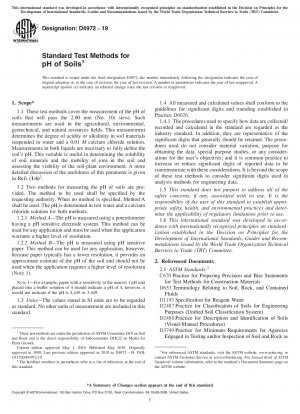ASTM D4972-19
Standard Test Methods for pH of Soils
- Standard No.
- ASTM D4972-19
- Release Date
- 2019
- Published By
- American Society for Testing and Materials (ASTM)
- Latest
- ASTM D4972-19
- Scope
- 1.1 These test methods cover the measurement of the pH of soils that will pass the 2.00 mm (No. 10) sieve. Such measurements are used in the agricultural, environmental, geotechnical, and natural resources fields. This measurement determines the degree of acidity or alkalinity in soil materials suspended in water and a 0.01 M calcium chloride solution. Measurements in both liquids are necessary to fully define the soil’s pH. This variable is useful in determining the solubility of soil minerals and the mobility of ions in the soil and assessing the viability of the soil-plant environment. A more detailed discussion of the usefulness of this parameter is given in Refs (1-6)2 . 1.2 Two methods for measuring the pH of soils are provided. The method to be used shall be specified by the requesting authority. When no method is specified, Method A shall be used. The pH is determined in test water and a calcium chloride solution for both methods. 1.2.1 Method A—The pH is measured using a potentiometer having a pH sensitive electrode system. This method can be used for any application and must be used when the application warrants a higher level of resolution. 1.2.2 Method B—The pH is measured using pH sensitive paper. This method can be used for any application, however, because paper typically has a lower resolution, it provides an approximate estimate of the pH of the soil and should not be used when the application requires a higher level of resolution (Note 1). NOTE 1—For example, paper with a sensitivity to the nearest 1 pH unit placed into a buffer solution of 4 should indicate a pH of 4, however, it would not indicate if the pH is 4.449 or 3.449. 1.3 Units—The values stated in SI units are to be regarded as standard. No other units of measurement are included in this standard. 1.4 All measured and calculated values shall conform to the guidelines for significant digits and rounding established in Practice D6026. 1.4.1 The procedures used to specify how data are collected/ recorded and calculated in the standard are regarded as the industry standard. In addition, they are representative of the significant digits that generally should be retained. The procedures used do not consider material variation, purpose for obtaining the data, special purpose studies, or any considerations for the user’s objectives; and it is common practice to increase or reduce significant digits of reported data to be commensurate with these considerations. It is beyond the scope of these test methods to consider significant digits used in analysis methods for engineering data. 1.5 This standard does not purport to address all of the safety concerns, if any, associated with its use. It is the responsibility of the user of this standard to establish appropriate safety, health, and environmental practices and determine the applicability of regulatory limitations prior to use. 1.6 This international standard was developed in accordance with internationally recognized principles on standardization established in the Decision on Principles for the Development of International Standards, Guides and Recommendations issued by the World Trade Organization Technical Barriers to Trade (TBT) Committee.
ASTM D4972-19 Referenced Document
- ASTM C670 Standard Practice for Preparing Precision and Bias Statements for Test Methods for Construction Materials
- ASTM D1193 Standard Specification for Reagent Water
- ASTM D2487 Standard Test Method for Classification Of Soils For Engineering Purposes
- ASTM D2488 Recommended Practice for Description Of Soils (Visual-Manual Procedure)
- ASTM D3740 Standard Practice for Minimum Requirements for Agencies Engaged in the Testing and/or Inspection of Soil and Rock as Used in Engineering Design and Construction
- ASTM D4220/D4220M Standard Practices for Preserving and Transporting Soil Samples*, 2024-04-22 Update
- ASTM D4753 Standard Specification for Evaluating, Selecting, and Specifying Balances and Scales for Use in Soil, Rock, and Construction Materials Testing
- ASTM D6026 Standard Practice for Using Significant Digits in Geotechnical Data
- ASTM D653 Standard Terminology Relating to Soil, Rock, and Contained Fluids
- ASTM D6913 Standard Test Methods for Particle-Size Distribution (Gradation) of Soils Using Sieve Analysis
- ASTM G51 Standard Test Method for Measuring pH of Soil for Use in Corrosion Testing
ASTM D4972-19 history
- 2019 ASTM D4972-19 Standard Test Methods for pH of Soils
- 2018 ASTM D4972-18 Standard Test Methods for pH of Soils
- 2013 ASTM D4972-13 Standard Test Method for pH of Soils
- 2001 ASTM D4972-01(2007) Standard Test Method for pH of Soils
- 2001 ASTM D4972-01 Standard Test Method for pH of Soils
- 1995 ASTM D4972-95a Standard Test Method for pH of Soils
